Hubei Food – Cuisine of Hubei in Central China
Chinese Name: 楚菜/湖北菜 chǔ cài/hú běi cài
English Names: Hubei cuisine, Chu cuisine, E cuisine, Hupei food, Hupeh food
Popular in: China’s Hubei Province
Flavors: umami, a little spicy, original
Famous Hubei Dishes: Steamed Wuchang Fish, Mianyang Three Steams, Hot Dry Noodles, Lotus Root Soup with Pork Ribs, Dragon and Phoenix
Famous Snacks: Tri-delicacy Doupi, Pearl Meatballs, Salty Doughnut, Dongpo Cake
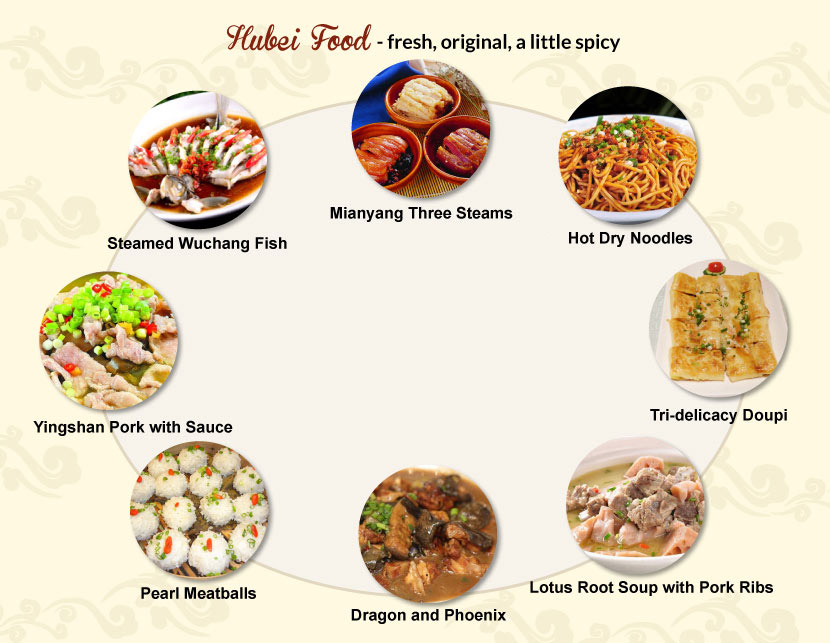 |
History of Hubei Cuisine
Hubei cuisine is originated in Jianghan Plain in Hubei Province. Based on the historic records, Chu cuisine had been formed in Spring and Autumn Period (770 - 476 BC). At that time, there had been over 20 nice dishes in the court banquet of Chu State together with exquisite cooking and eating wares. Experiencing the development of almost two thousand years, it became matured in Ming (1368 - 1644 AD) and Qing (1644 - 1911 AD) Dynasties. Now, it is one of the top ten Chinese cuisines.
Popular Ingredients: Local Freshwater Fishes
Hubei is one of the provinces having most lakes and rivers in China. Fishes, especially the freshwater fishes, are the most important ingredients in Hubei cuisine recipes. There are black carps, crucians, carps, chubs, eels and more than 50 kinds of fishes in total. The famous Wuchang Fish is from Ezhou, Wuchang in ancient time. These fishes can be braised, steamed, steamed in rice four or boiled in hot pot.
One Dish with Multiple Ingredients
Hubei dishes are usually cooked with multiple ingredients. For example, Braised Fish Balls, Pork Balls and Sliced Meat of Huangpi. Varied food materials with different nutrition can not only promote nutritive value of dishes, but also play a role in seasoning and adding colors to make dishes nicer.
“Balls” and Soups are Popular.
Hubei people like shaping varied ingredients into balls, such as pork balls, fish balls, shrimp balls and so on. There are dozens of “ball” dishes seen not only in common families but also grand restaurants. And each kind of ball has its own flavor.
They like soups as well, like sparerib soup, chicken soup, beef soup, mutton soup, etc. The most nutritious one is the turtle soup. All in all, fishes, meat, vegetables, wild games, delicacies from land and sea can all be used to cook soup. Lotus Root Soup with Pork Ribs is the favorite soup of common Hubei families.
Few Colored Condiments in Hubei Food
Hubei dishes are required to maintain the original color, taste and sauce while cooking. Thus few colored condiments are applied. Steamed Wuchang Fish and Steamed Pearl Meatballs are the typical representatives.
Special Cooking Techniques
More than 30 cooking techniques are seen in Hubei cuisine recipes. The mostly used skills are steaming, stewing, deep-frying, braising and frying. Cutting and slicing skill is also important in Chu cuisine. The chefs cut meat on a cloth when they practice, and meat is cut while cloth is undamaged.
The Most Famous Hubei Dishes
Steamed Wuchang Fish
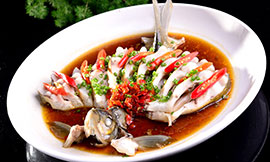
The Wuchng fish is from Ezhou, Hubei and is steamed with dried mushrooms, winter bamboo shoots, hams, shallot, ginger and multiple condiments. The fish is tender and the taste is light.
Mianyang Three Steams
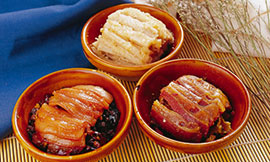
In the important Hubei food, three kinds of ingredients that include fisheries, fowls and vegetables are steamed and served together. The ingredients are often covered with rice flour before steaming.
Hot Dry Noodles
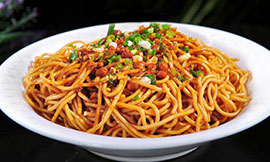
Hot Dry Noodles is one of the most famous food in Wuhan. The cooked oily noodles with yellow color make people mouth-watering. One can also choose different condiments based on your taste.
Tri-delicacy Doupi
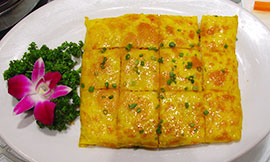
It is a traditional snack in Wuhan is made from glutinous rice and bean curd sheet with meat, eggs and shrimps stuffed inside, shaped square and fried in a pan, having a flavor of egg, shrimp and meat.
Lotus Root Soup with Pork Ribs
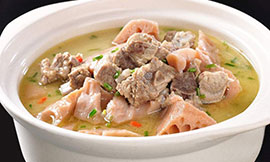
Lotus Root Soup with Pork Ribs is stewed in small earthen jar until lotus root and ribs become tender. It is delicious and nutritious with fresh lotus roots, aromatic ribs and thick soup.
Dragon and Phoenix
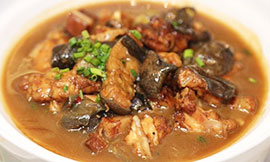
Cooked with fish and chicken, the fish tastes sour and sweet, while the chicken is salty and a little spicy. This dish stands for auspicious omen, which is usually served on wedding banquets.
Menu of Hubei Food
| English | Chinese | Pinyin |
|---|---|---|
| Steamed Wuchang Fish | 清蒸武昌鱼 | qīng zhēng wǔ chāng yú |
| Mianyang Three Steams | 沔阳三蒸 | miǎn yáng sān zhēng |
| Hot Dry Noodles | 热干面 | rè gān miàn |
| Tri-delicacy Doupi | 三鲜豆皮 | sān xiān dòu pí |
| Lotus Root Soup with Pork Ribs | 排骨藕汤 | pái gǔ ǒu tāng |
| Dragon and Phoenix (Stewed Fish and Chicken) | 龙凤配 | lóng fèng pèi |
| Pearl Meatballs | 珍珠圆子 | zhēn zhū yuán zǐ |
| Yingshan Pork with Sauce | 应山滑肉 | yìng shān huá ròu |
| Braised Fish Balls, Pork Balls and Sliced Meat of Huangpi | 黄陂三合 | huáng pí sān hé |
| Sautéed Preserved Pork with Red Vegetables | 红菜苔炒腊肉 | hóng cài tái chǎo là ròu |
| Braised Captive-Reared Mallard with Sugar | 红烧野鸭 | hóng shāo yě yā |
Best Hubei Cuisine Restaurants in China
![]() Hujin Restaurant
Hujin Restaurant
Chinese Name: 湖锦酒楼
Location: No.105, Bayi Road, Wuchang District, Wuhan
No.28, Boxue Road, Economic Development Zone, Wuhan
No.1037, Luoyu Road, Hongshan District, Wuhan![]() Kang-Long-Tai-Zi Restaurant
Kang-Long-Tai-Zi Restaurant
Chinese Name: 亢龙太子酒轩
Location: No.181, Donghu Road, Wuchang District, Wuhan
No.711, Jianshe Avenue, Jianghan District, Wuhan
No.226, Yanjiang Avenue, Jiangan District, Wuhan![]() Chu Wei Farm Restaurant
Chu Wei Farm Restaurant
Chinese Name: 楚味农庄
Location: No.349, Zhenda Road, Baoshan District, Shanghai
No. 1539, Caobao Road, Minxing District, Shanghai
No. 1208, Xinhu Road, Baoshan District, Shanghai![]() Yellow Crane Tower
Yellow Crane Tower
Chinese Name: 黄鹤楼
Location: 2nd Floor, China Electronic Information Mansion, No.6, South Street, Zhongguancun, Beijing
5 Subgroups of Hubei Cuisine
There are more than one way to classify the main styles or subgroups of Hubei food. The five branches here is the mostly recognized classification, which divides Chu cuisine into Wuhan, Jingsha, Ezhou, Xiangyun and Southwest Hubei sub-cuisines.
Centered in Wuhan, Wuhan cuisine also includes the cuisines of Xiantao, Hanyang, Huangpi, Mianyang and Xiaogan. Taking the freshwater fishes and stewed soups seriously, it is the vital part of Chu cuisine. The representative dishes are Mianyang Three Steams, Braised Fish Balls, Pork Balls and Sliced Meat of Huangpi, etc.
Jingsha refers to Jianghan Plain, including the cities of Jingzhou, Shashi and Yichang. The fish cakes and steamed dishes are well-known. Braised Captive-Reared Mallard with Sugar and Thong-Liked Eel are the most famous dishes.
Ezhou cuisine popular in Ezhou, Huangshi and Huangzhou is the local food in southeast Hubei. Those dishes are oily with a fresh flavor. Steamed Wuchang Fish is the representative.
Xiangyun cuisine is popular in Xiangyang and Yunyang, which are in northern Hubei. The main ingredients are pork, beef and mutton. Fishes are only the supplement. The dishes are mostly grilled, braised and deep-fried.
Southwest Hubei cuisine is the food of local Miao nationality, covering an area of Enshi, Jianshi, Badong, Hefeng and nearby regions. The dishes are sour and spicy. Marinated fishes are popular there.